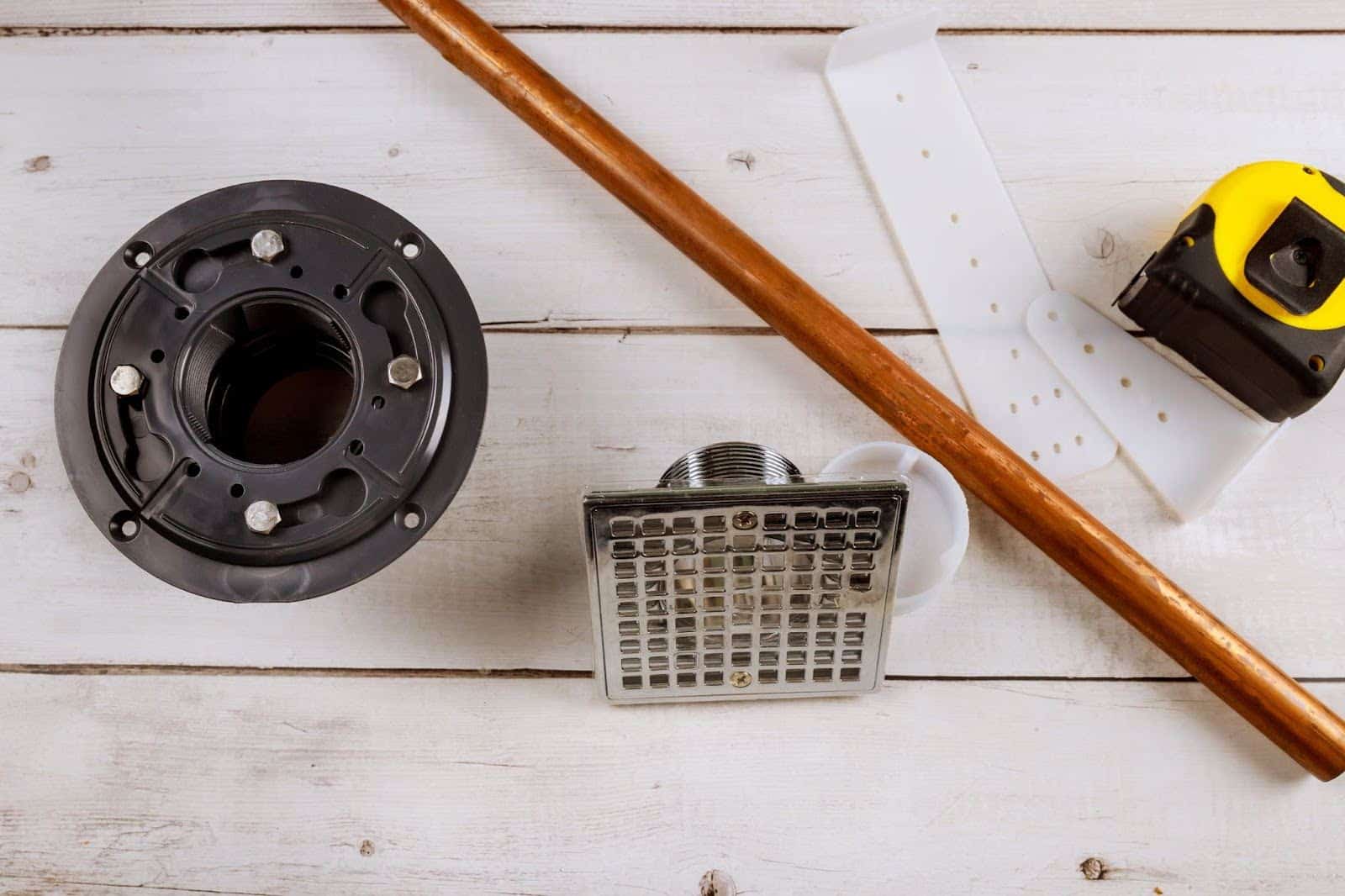You’re enjoying a long, relaxing shower, and suddenly, the water starts to pool around your feet. It’s not draining fast enough, and soon, you’re standing in a mini lake in your shower. This is a common problem that many homeowners face: clogged or improperly plumbed shower drains. Whether you’re building a new shower or renovating your bathroom, understanding how to plumb a shower drain properly is essential to avoid future headaches. In this guide, we’ll walk you through the steps to ensure your shower drain is set up correctly, saving you time, money, and frustration down the road.
Let’s start by answering some of the most important questions about shower drain plumbing.
What Is Shower Drain Plumbing?
Shower drain plumbing refers to the system of pipes and components that carry waste water away from your shower and into the home’s main sewer system.
A properly installed shower drain system ensures that water flows smoothly and quickly out of the shower area. Improper installation can lead to slow drainage, leaks, or even water damage. To help avoid these issues, understanding the correct procedure for shower drain installation is crucial.
Components of a Shower Drain System
- Drain Pan: Collects and channels water to the drainpip
- P-Trap: Prevents sewer gases from entering your home.
- Drain Pipe: Connects the shower drain to the home's main drainage system.
- Shower Drain: The part visible in the shower floor that allows water to flow out.
By ensuring each component is properly installed and connected, you’ll have a functioning and efficient shower drain system.
Why Is Proper Shower Drain Installation Important?
Proper shower drain installation ensures that water drains efficiently, preventing pooling and potential water damage to the bathroom.
When a shower drain is improperly installed, several issues can arise. Water may not drain correctly, leading to standing water in your shower. Over time, this can cause mold growth, unpleasant odors, and potentially even damage to the floor structure. For these reasons, ensuring your shower drain is installed correctly from the start is essential for maintaining the longevity and functionality of your bathroom.
Common Problems Caused by Improper Shower Drain Installation
- Slow water drainage.
- Water pooling or flooding.
- Mold and mildew growth.
- Structural damage due to water leaks.
By following the correct procedures for shower drain plumbing, you can avoid these common issues.
What Are the Key Steps for Shower Drain Plumbing?
The key steps for shower drain plumbing include preparation, installation, and proper sealing of all connections.
Proper shower drain plumbing isn’t just about installing the drain itself. It requires careful planning, correct pipe connections, and appropriate sealing to ensure everything works seamlessly. Here’s a general overview of the steps involved:
- Prepare the Drain Area: Start by ensuring the shower floor is level and free from debris.
- Install the Drain Pan: This part will direct water to the drain.
- Fit the Drain: Attach the drain to the pan and connect it to the drainpipe.
- Install the P-Trap: The P-trap should be positioned correctly to prevent sewer gases from backing up into the shower.
- Seal the Drain: Use a strong sealant around the connections to prevent leaks.
Proper planning and execution during these steps will help ensure that your shower drain works efficiently for years.
How to Install a Shower Drain?
Installing a shower drain involves connecting the drain to the shower pan and ensuring that the plumbing is set up correctly.
The process starts with ensuring the floor of your shower is properly prepared. The shower pan should be securely installed, followed by the attachment of the drain. Here’s a breakdown of the installation process:
Step-by-Step Shower Drain Installation
- Position the Drain Pan: Make sure the shower pan is level and properly installed.
- Insert the Drain Flange: The flange should be secured to the pan, allowing water to flow into the drain pipe.
- Connect the Drain Pipe: Use PVC pipes or ABS piping to connect the drain to the home's main plumbing system.
- Install the P-Trap: The P-trap should be installed below the drain to prevent odors and gases from entering the bathroom.
- Test for Leaks: Once everything is connected, turn on the water and check for leaks around the drain.
Tools You’ll Need for Installation
- A pipe cutter or saw.
- Plumber's tape.
- PVC cement or ABS cement.
- Adjustable wrench.
- Level.
By following these steps and using the right tools, you’ll ensure your shower drain installation is done correctly.
What Are Plumbing Tips for Shower Drain Maintenance?
Regular maintenance ensures your shower drain remains clear and free of blockages.
While installing the shower drain correctly is essential, ongoing maintenance is key to keeping the system working efficiently. Here are some plumbing tips to help maintain your shower drain:
- Clean the Drain Regularly: Remove hair and debris from the drain grate to prevent clogs.
- Flush with Hot Water: Every few weeks, pour hot water down the drain to help clear minor blockages.
- Use Drain Covers: Prevent debris from entering the drain by using a mesh cover.
- Check for Leaks: Regularly inspect the drain and surrounding pipes for leaks to avoid water damage.
By incorporating these maintenance tips, you’ll reduce the likelihood of drain issues and keep your shower running smoothly.
How Do You Deal with Shower Drain Blockages?
Dealing with shower drain blockages involves identifying the cause and using the appropriate method to clear it.
Blockages in shower drains are common, and they can often be cleared without the need for professional help. The blockage may be due to hair, soap scum, or foreign objects. Here are the steps to deal with blockages:
Common Causes of Blockages:
- Hair buildup.
- Soap scum and grime.
- Foreign objects in the drain.
How to Clear a Shower Drain Blockage:
- Use a Plunger: Create a seal over the drain and plunge to loosen the blockage.
- Try a Drain Snake: A drain snake can reach deeper blockages and clear the pipe.
- Chemical Drain Cleaners: Use a safe, non-corrosive drain cleaner to break down the blockage.
- Call a Professional: If the blockage persists, it might be time to call a plumber to resolve the issue.
By regularly checking for blockages and addressing them early, you’ll keep your shower drain working efficiently.
How to Prevent Future Shower Drain Problems?
Preventing future shower drain problems involves good habits and regular maintenance.
The best way to avoid shower drain issues is through prevention. By following simple maintenance practices, you can extend the lifespan of your drain system. Here’s how:
- Use Drain Guards: Prevent hair and debris from entering the drain by using a drain guard.
- Avoid Harsh Chemicals: Harsh chemicals can corrode pipes and seals, so avoid them.
- Schedule Professional Inspections: Have a plumber inspect the drain system periodically to catch potential issues before they become major problems.
These preventative measures will help you avoid costly repairs and keep your shower drain functioning properly.
Takeaways
Plumbing a shower drain may seem daunting, but with the right tools, knowledge, and steps, it’s a manageable task. By following this guide, you’ll ensure that your shower drain system is properly installed and maintained. A properly plumbed shower drain not only prevents water damage but also improves the overall functionality of your bathroom. If you’re unsure about the process or encounter any issues along the way, don’t hesitate to reach out to the experts at OnPoint Plumber. We’re here to help with all your plumbing needs.
Ready to get your shower drain system installed or inspected? Contact OnPoint Plumber today and ensure your plumbing is in top condition!
Frequently Asked Questions
What’s the most common problem with shower drains?
The most common issue with shower drains is clogging, often caused by hair and soap scum. Regular cleaning and maintenance can prevent this.
Can I install a shower drain myself?
Yes, you can install a shower drain yourself if you have basic plumbing skills. Follow the steps carefully and use the right materials.
How can I prevent my shower drain from clogging?
Use a drain guard to catch hair and debris, and flush the drain with hot water regularly to clear any buildup.
How often should I maintain my shower drain?
It’s best to clean your shower drain every month. Performing occasional checks for leaks and clogs is also recommended.
When should I call a plumber for my shower drain?
If you notice slow drainage, persistent blockages, or water damage around the drain, it’s time to call a professional plumber to inspect your system.

